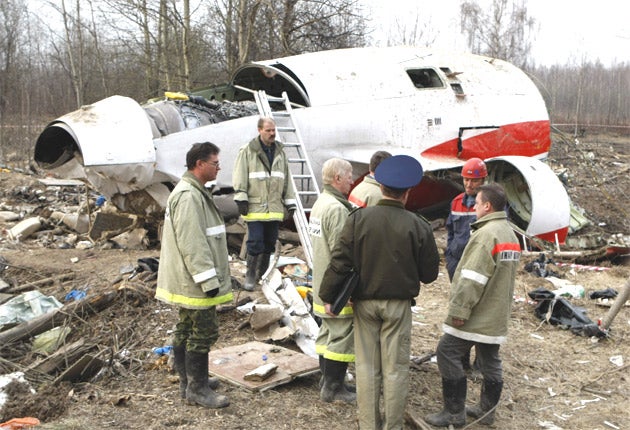Russia's flying workhorse may be banned after deadly crash

Your support helps us to tell the story
From reproductive rights to climate change to Big Tech, The Independent is on the ground when the story is developing. Whether it's investigating the financials of Elon Musk's pro-Trump PAC or producing our latest documentary, 'The A Word', which shines a light on the American women fighting for reproductive rights, we know how important it is to parse out the facts from the messaging.
At such a critical moment in US history, we need reporters on the ground. Your donation allows us to keep sending journalists to speak to both sides of the story.
The Independent is trusted by Americans across the entire political spectrum. And unlike many other quality news outlets, we choose not to lock Americans out of our reporting and analysis with paywalls. We believe quality journalism should be available to everyone, paid for by those who can afford it.
Your support makes all the difference.In response to a mysterious plane crash on New Year's Day, Russia is considering grounding its entire fleet of Tupolev-154s, the medium-range jetliner that was the workhorse of Soviet aviation.
Nearly 200 Tu-154s are still in use across Russia and the former Soviet countries, but the model's future is now in doubt. In the most recent incident, the engines of a Tu-154 belonging to the small regional company Kogalym Avia caught fire as the jet was taxiing for take-off at a Siberian airport last week. The plane was evacuated, but three people were killed and 39 were in hospital.
Already, the country's aviation authorities have banned all flights by the 154-B model, the older type which was involved in last week's accident. President Dmitry Medvedev ordered Russia's Transport Minister to investigate the incident, and said in televised remarks that he could not rule out a full ban on the use of all remaining Tupolev-154s.
The country's national carrier, Aeroflot, has phased out all Tu-154s, and the company now uses only Western aircraft on all short and medium haul routes. The Tu-154 is mostly used by smaller air companies, of which there are dozens in Russia. Many of them have only a handful of planes and run only one or two routes.
There have been several crashes involving the aircraft in the past year. Last month, a Tu-154 belonging to Dagestan Airlines lost power in all three engines after taking off from a Moscow airport. The pilots managed to bring the plane down at a different Moscow airport, but in the crash-landing two people were killed and dozens injured. The emergency exit slides did not work either, meaning that injured passengers had to be tossed out from the plane to rescuers waiting below.
The most high-profile recent crash involving the Tu-154 was last April, when the presidential Tupolev of Poland's leader Lech Kaczynski crashed on approach to the runway at Russia's Smolensk airport, killing everyone on board, including Mr Kaczynski, his wife, and dozens of Poland's political and intellectual elite. That crash appears to have been caused by the decision to land in poor visibility conditions, rather than a fault with the plane.
Russian aviation experts claim that the plane is safe and that most incidents are due to pilot error, poor maintenance, and the challenging weather conditions in which the plane often operates. But they admit that it is extremely fuel-inefficient, as well as noisy, and that means the craft is banned from some European airports.
"The Tu-154 is a whole epoch in Russian aviation, for both pilots and passengers," wrote Mikhail Vasilenko, the chief executive of Moscow's Sheremetyevo airport in his blog yesterday. "It's clear that this plane already can't compete with modern Boeings and Airbuses in safety, noise levels or comfort... But to ban the use of 154s in the current climate would be a crushing blow to regional airlines, who would in some cases have to change their entire fleet."
But flying on a Tu-154 today is rarely a pleasant experience, partly because most of the planes have outdated, shabby interiors. The plane is divided into two salons, and a bizarre flaw in the heating system often means that the front cabin is roasting hot while the rear cabin is freezing cold. The overhead bins often open during takeoff and landing, depositing bags on passengers' heads.
"I'm not a nervous flier, but every time I get on one of those things I feel like it could be the end," says one Western businessman who frequently uses Tu-154s to fly to western Siberia. "They are the only planes that fly where I need to go, and I'd be absolutely delighted if they were taken out of service forever."
The plane truth
54 The number of crashes to involve the Tu-154 since it entered flight service in 1971.
2,860 The number of deaths that have resulted from those crashes.
431,200 Flights the Tu-154 makes for every fatal accident. In comparison, the Boeing-737 has a fatal accident every 2,680,000 flights.
900 Tu-154 planes have been produced. About 250 remain in service, mostly with small airlines. Aeroflot has none now.
137m Passengers who flew on Tu-154s during 1990, its year of greatest use, equivalent to 244 billion passenger kilometres.
$45m Typical cost of a Tu-154 in 2008. The most modern Boeing 737s cost about $85m.
Join our commenting forum
Join thought-provoking conversations, follow other Independent readers and see their replies
Comments